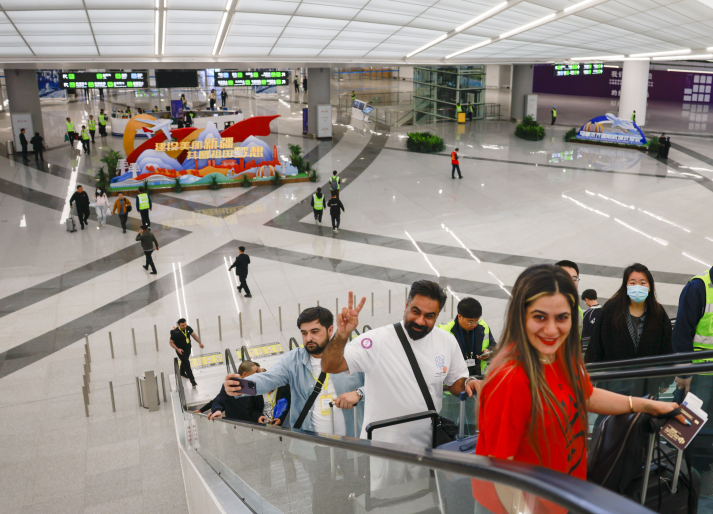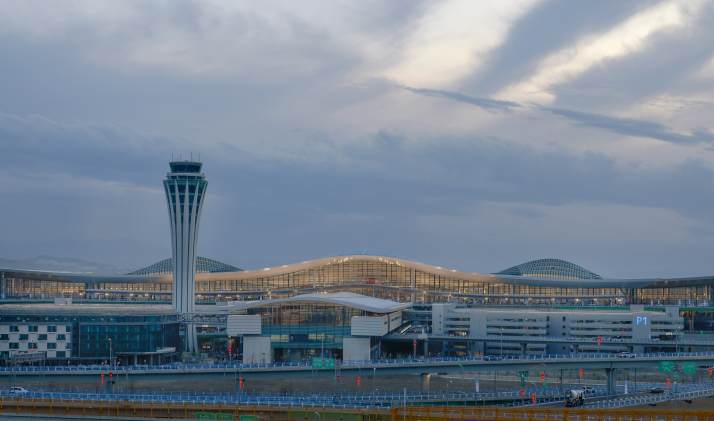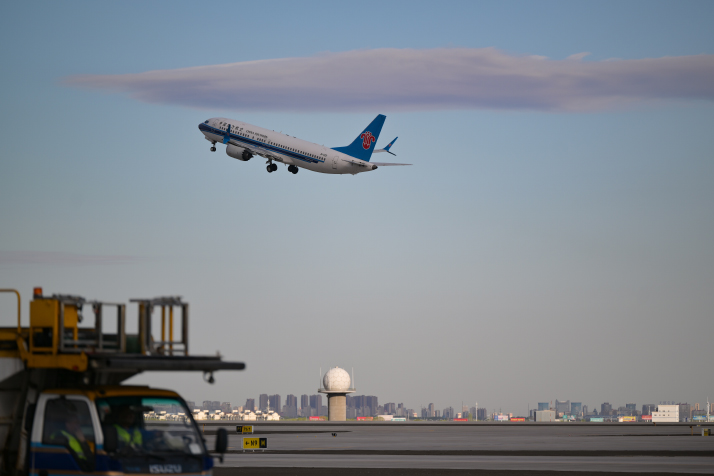| Xinjiang Today |
| Air hub at the frontier | |
|
|
 Passengers at the departure hall of a new terminal at Urumqi Tianshan International Airport on April 17 (XINHUA)
On April 17, Xinjiang Airport Group announced the opening of a new terminal at Urumqi Tianshan International Airport, previously known as Urumqi Diwopu International Airport. The new terminal more than triples the airport's annual passenger and cargo handling capacity, assisting it to play a greater role as a major international aviation hub.
As one of China's top 10 international airports, the airport in Urumqi, capital of Xinjiang Uygur Autonomous Region, has undergone four rounds of development and expansion—each bringing new momentum to this once-remote frontier city.  Urumqi Tianshan International Airport in Urumqi, Xinjiang Uygur Autonomous Region, on April 15 (XINHUA)
Skyward growth The Urumqi airport has grown from a regional facility to an international air hub it is today, under the support of the Central Government of China. The first round of development, beginning in the 1970s, saw the construction of Xinjiang's first terminal and a 3,200-meter concrete runway. Before that, the airport's runway had been naturally formed dirt paths on Gobi desert land, where planes had taken off and landed on unpaved strips without ground navigation lights. After the expansion, new routes to Beijing and Shanghai were launched, bringing to an end an era when Xinjiang's civil aviation operated solely within the region. Another expansion, completed in 2001, added Terminal 2 and other supporting infrastructure. Over 40 new domestic routes were opened, significantly enhancing operational capacity. The third expansion, completed in 2010, delivered Terminal 3 and major upgrades including an expanded apron. During this phase, the airport launched international routes to cities such as Islamabad, Almaty, and Moscow, forming an international network of passenger and freight transportation, connecting Asia and Europe. The latest expansion has tripled capacity by upgrading from one runway to three. The airport can now handle 48 million passengers, 550,000 tons of cargo, and 367,000 aircraft movements annually. According to the Civil Aviation Administration of China (CAAC), Xinjiang has benefited from national civil aviation infrastructure investment—over 12 billion yuan ($1.6 billion) from the Civil Aviation Development Fund and an additional 3 billion yuan ($414 million) from the Central Government budget have been allocated to the four stages of the airport's development. "With the completion of all four stages, the airport will better serve national strategies, regional socioeconomic development, and the travel needs of the people," Yang Hongfeng, General Manager of Urumqi International Airport under Xinjiang Airport Group, said.  An airplane bound for Guangzhou of Guangdong Province, south China, takes off at Urumqi Tianshan International Airport on April 17 (XINHUA)
Cultural connector Arriving at the new terminal, travelers are greeted by the wave-shaped metal ceiling inspired by the snowy ridges of the Tianshan Mountains. The terminal's design has also drawn inspirations from the Silk Road camel caravan routes. Digitally restored murals from the Kizil Caves come alive through augmented reality—by scanning a QR code on the wall, visitors can watch stories of Kuchean music and dance in multiple languages. The airport has brought visitors from far and wide to Xinjiang. "The night view of the International Grand Bazaar in Urumqi is stunning, and the variety of food is just irresistible," Giorgadze Mirian, a tourist from Tbilisi, Georgia, told Xinjiang Daily. In March, he visited Urumqi with his family, and was impressed by both the experience and the convenience—thanks to a direct flight from his hometown. "It takes only five hours, and the ticket prices are quite reasonable," he added. Currently, this Urumqi airport operates 207 domestic routes and 26 international routes, covering Central Asia, West Asia, and parts of Europe. This ever-expanding network has made travel more accessible, spurring a surge in tourism. Cultural exchange and interpersonal bonds between tourists and local communities have grown closer than ever. According to the 2025 Xinjiang Culture and Tourism Work Conference, Urumqi welcomed 121 million tourist visits in 2024, a year-on-year increase of 14.03 percent. "As a city's window to the world, the airport is not only a transportation hub—it's also a platform for cultural exchange," He Mingxing, a scholar at Xinjiang University, told Xinjiang Daily. A global hub Urumqi's aviation development has been fueled by national government policies. Liu Zhengyan, a retired cargo department employee of China Southern Airline's Xinjiang branch, has been amazed by the airport's transformation. "There was a time when the airport didn't have a single stable international cargo route," he recalled in an interview with Xinjiang Daily. "Now it's a completely different story." With the Belt and Road Initiative, a China-proposed initiative to boost connectivity along and beyond the ancient Silk Road routes, and the Xinjiang Free Trade Zone policy taking effect, Urumqi has evolved from a remote inland city into an open frontier of international commerce. With its expanded capacity and enhanced connectivity, the airport evolves from a regional gateway into a bridge linking China with Central and West Asia. Thanks to new cargo routes, fresh cherries from Central Asia can now reach Urumqi in as little as two hours—much to the delight of local residents. According to Zhang Weijie, Deputy Director of Customs at Urumqi Tianshan International Airport, the airport added international passenger and cargo routes to 22 destinations in 16 countries in 2024—including cities such as Khujand in Tajikistan, Yerevan in Armenia, Kuala Lumpur in Malaysia, London in United Kingdom, and Katowice in Poland. Imports arriving through the airport include cherries, camel milk, clothing, and footwear. The Air Silk Road has become a vital artery for regional connectivity. Customs statistics show that Urumqi's foreign trade totaled 13.15 billion yuan ($1.8 billion) in January–February 2025, up 21.2 percent year on year and ranking first in Xinjiang, with exports standing at 10.49 billion yuan ($1.4 billion) and imports at 2.66 billion yuan ($367 million). As new international routes continue to be launched, the airport is leveraging policy support related to the China (Xinjiang) Pilot Free Trade Zone to further extend its functions. Innovations such as bonded aviation fuel refueling and bonded aircraft maintenance have taken off, which are specialized services offered in international airports within customs-bonded areas to facilitate global aviation operations without incurring immediate customs duties or taxes. A public bonded warehouse has been launched, boosting the region's hi-tech and high-value aviation sector. "We're developing a comprehensive 'aviation plus logistics' ecosystem," Yang said. "This will strengthen the airport's role in the international aviation and build stronger air bridges between China and Eurasia." The author holds a Ph.D. in international communication from Beijing Foreign Studies University and has extensive work experience in Xinjiang Uygur Autonomous Region Comments to lixiaoyang@cicgamericas.com |
|
||||||||||||||||||||||||||||
|